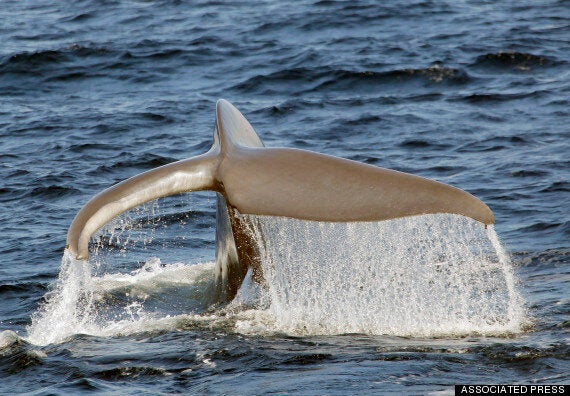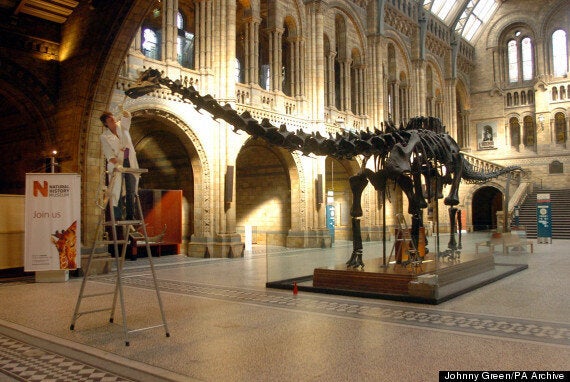Like any child who ever visited the Natural History Museum, I loved Dippy The Diplodocus.
I even remember the first time I saw her. This was back in the strange, misty, pre-Jurassic Park world of 1991, when dinosaurs were still as alien and unreal as, well, aliens. I had picture books of ancient animals, and I'd seen photos of dinosaur skeletons. But the idea of seeing a real one had never occurred to me.
So when I walked into the central hall of the NHM on that cold, rainy day in Kensington, I pretty much lost my mind at first sight.
Dippy was astonishing. I remember gawking at her long, sloping tail and her tiny, noble head, her strange, plodding legs and the impossibly long rivers of time that separated our lives. And yes, I wondered what the chances were that she might come back to life in order to let me ride on her back all the way home. The robot dinosaurs in the room next door were cool too. But Dippy took first place.
So naturally when I heard that the NHM wants to replace Dippy's position in the hall with a blue whale by 2017, my first instinct was to express the sort of outrage for which Twitter, and increasingly modern life as a whole, is noted.
I was wrong. It's time to let Dippy go.

Why? Well, firstly, because - let's face it - Dippy isn't even a dinosaur. She's a fake - a plaster cast set of 292 bones, taken from a fossil discovered in Wyoming.
That's not necessarily that important - fossils are themselves, in a sense, 'casts' of bones and not the 'real thing' anyway. But it's a bit of a downer when there's so much else to wonder at in the museum that is real. The blue whale skeleton (let's call it "Bluey" for short) that will replace Dippy is one of them, having been beached on the Irish coast in 1891, bought for £250 (minus the meat and oil, sold for profit by the man who found it) and displayed in the museum since 1938.
But regardless of whether that matters to you, there is a bigger reason to shove Dippy aside (to a nearby dinosaur exhibit, not the scrap heap) and put Bluey in her place.
It's because Bluey still exists.
And only just.
Blue Whales were once abundant in all oceans on Earth. Starting from the nineteenth century, when there were around 240,000 blue whales in existence. Then, because humans, they were hunted almost to extinction, dropping to around 10,000 in number by 2002. Fortunately there are good signs that in the waters off California, at least, conservation is working. But there are also haunting warnings from researchers that the ocean as a whole is on the brink of the same scale of extinction which killed off poor old Dippy - or rather her descendants. We are right on the precipice of losing Bluey and everything else that lives in the water, through actions that we ourselves control.
That's why its story matters.

There is no doubt in my mind that as a physical display, Bluey will amaze kids just as profoundly, or even more so, as Dippy used to as a physical object. It really can't fail. Bluey is already a stupendous specimen, and will be even more dramatic in its new pose, diving from the rafters of the Hintze Hall down to the kids staring back up from the floor. And where Dippy is a relatively small, static dinosaur, Bluey is the largest thing that ever lived - a number one, gold plated, Guinness Book of Records-dominating winner of an animal.
But what will dazzle children even more than Bluey's simple size is that not only did this animal once exist, it still does. You can't get in a plane and go to see Dippy wandering around the savannah of Africa. But you can get in a boat and see Bluey, if you're lucky. The largest animal in history is real, and living, now. We share a planet with this thing. We are incredibly lucky to do so.
The story of evolution is one of animals adapting to, and changing their environment. Dippy the Diplodocus was doomed by time and - eventually, its descendants bought the sharp end of an asteroid. It is not that dinosaurs are "irrelevant", as some have said - they are relevant, which is why they form such a central part of the entire Natural History Museum experience. It's not even that they are finished evolving.
But the Blue Whale as a central motif for the NHM is so much more profound than Dippy could ever be. We still share a planet, and a destiny, with this weightless behemoth, and now we'll share the central hall of the Natural History Museum with it too - along with Darwin himself, of course.

As for Dippy? Well even after 155 million years there's life in the old plaster cast yet. It's off to the dinosaur hall next door, and then maybe a national tour. She will inspire children for many more generations to come.
There will be those that want to save it in its current place, of course, purely out of the same youth-mourning nostalgia that leads people to get angry about remakes of Ghostbusters - even though it was only put there in 1979. To them I say, check your nostalgia, nerds. This isn't about you.
It's about kids. It's about inspiring new generations of people to admire, understand and protect the natural world.
And if I ever have a child, I will look forward one day to taking them to the Natural History Museum, and watching their jaw drop to the floor when they see the remains of this magnificent beast.
'Look,' I will say. 'That's a blue whale. It's the largest thing that has ever lived. And they still swim in the ocean.'
At least, I hope to be able to.
